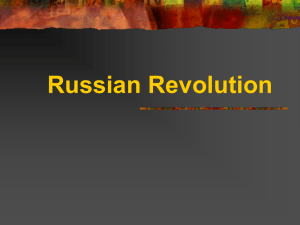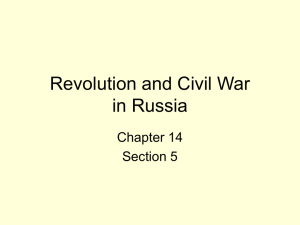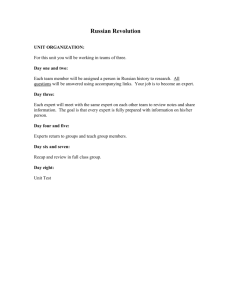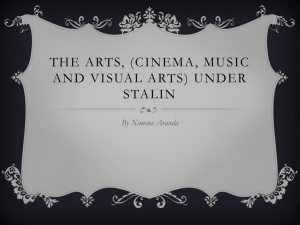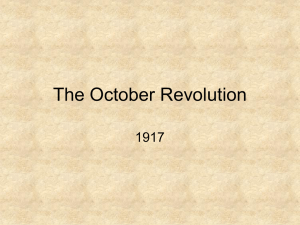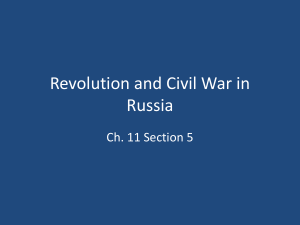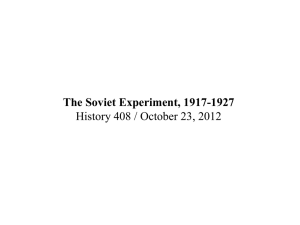how strong was the tsarist regime
advertisement
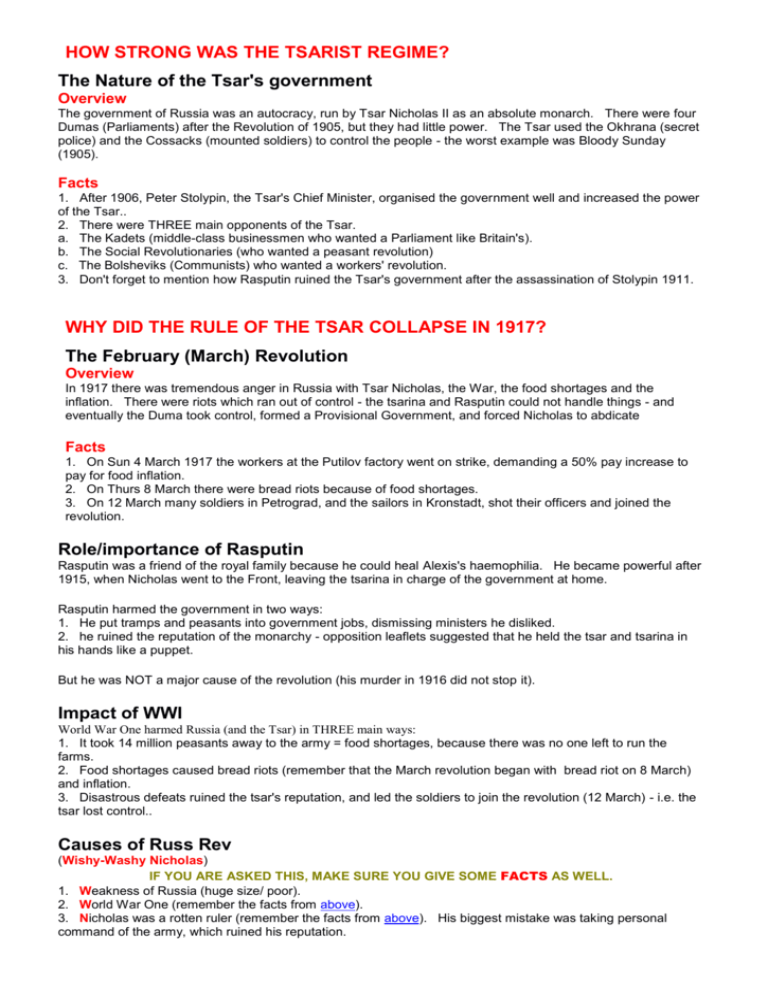
HOW STRONG WAS THE TSARIST REGIME?
The Nature of the Tsar's government
Overview
The government of Russia was an autocracy, run by Tsar Nicholas II as an absolute monarch. There were four
Dumas (Parliaments) after the Revolution of 1905, but they had little power. The Tsar used the Okhrana (secret
police) and the Cossacks (mounted soldiers) to control the people - the worst example was Bloody Sunday
(1905).
Facts
1. After 1906, Peter Stolypin, the Tsar's Chief Minister, organised the government well and increased the power
of the Tsar..
2. There were THREE main opponents of the Tsar.
a. The Kadets (middle-class businessmen who wanted a Parliament like Britain's).
b. The Social Revolutionaries (who wanted a peasant revolution)
c. The Bolsheviks (Communists) who wanted a workers' revolution.
3. Don't forget to mention how Rasputin ruined the Tsar's government after the assassination of Stolypin 1911.
WHY DID THE RULE OF THE TSAR COLLAPSE IN 1917?
The February (March) Revolution
Overview
In 1917 there was tremendous anger in Russia with Tsar Nicholas, the War, the food shortages and the
inflation. There were riots which ran out of control - the tsarina and Rasputin could not handle things - and
eventually the Duma took control, formed a Provisional Government, and forced Nicholas to abdicate
Facts
1. On Sun 4 March 1917 the workers at the Putilov factory went on strike, demanding a 50% pay increase to
pay for food inflation.
2. On Thurs 8 March there were bread riots because of food shortages.
3. On 12 March many soldiers in Petrograd, and the sailors in Kronstadt, shot their officers and joined the
revolution.
Role/importance of Rasputin
Rasputin was a friend of the royal family because he could heal Alexis's haemophilia. He became powerful after
1915, when Nicholas went to the Front, leaving the tsarina in charge of the government at home.
Rasputin harmed the government in two ways:
1. He put tramps and peasants into government jobs, dismissing ministers he disliked.
2. he ruined the reputation of the monarchy - opposition leaflets suggested that he held the tsar and tsarina in
his hands like a puppet.
But he was NOT a major cause of the revolution (his murder in 1916 did not stop it).
Impact of WWI
World War One harmed Russia (and the Tsar) in THREE main ways:
1. It took 14 million peasants away to the army = food shortages, because there was no one left to run the
farms.
2. Food shortages caused bread riots (remember that the March revolution began with bread riot on 8 March)
and inflation.
3. Disastrous defeats ruined the tsar's reputation, and led the soldiers to join the revolution (12 March) - i.e. the
tsar lost control..
Causes of Russ Rev
(Wishy-Washy Nicholas)
IF YOU ARE ASKED THIS, MAKE SURE YOU GIVE SOME FACTS AS WELL.
1. Weakness of Russia (huge size/ poor).
2. World War One (remember the facts from above).
3. Nicholas was a rotten ruler (remember the facts from above). His biggest mistake was taking personal
command of the army, which ruined his reputation.
WHY DID THE PROVISIONAL GOVERNMENT ONLY LAST 8 MONTHS?
The Provisional Government
Overview
In March 1917 the Duma formed a 'Provisional (= temporary) Government' and forced the tsar to abdicate. But it
never managed to do anything about its six problems (see below) - so nobody lifted a finger to help it when the
Bolsheviks revolted in November and it fell from power.
Facts
1 In March, the Petrograd Soviet issued Order No. 1 forbidding people to obey the provisional government
unless the Soviet agreed.
2. In April, the German government smuggled the Bolshevik leader Lenin back into Russia. (The Bolsheviks
rioted in July but were defeated.)
3. In August, there was a Tsarist revolt led by General Kornilov - he was only defeated by the Bolsheviks.
Six Problems of the Prov Gov
(SIPS BK)
1. The Petrograd Soviet was a rival for power (nb Order No.1).
2. Inflation and hunger got worse because the Prov Gov didn't end the war.
3. The Prov Gov angered the peasants by making them give back the nobles land they had taken.
4. The Prov Gov angered the soldiers by forming death squads to stop them deserting.
5. The Prov Gov did not stop Lenin and the Bolsheviks campaigning against it (remember Lenin's slogans 'Peace, Bread, Land').
6. General Kornilov tried a rebellion to bring back the Tsar in August 1917, and the Prov Gov could not stop him
(he was defeated by the Bolsheviks).
HOW WERE THE BOLSHEVIKS ABLE TO SEIZE POWER?
The Bolshevik Seizure of Power
Overview
The Bolsheviks power was growing throughout 1917 - in July they rioted, and in September they took control of
the Petrograd Soviet.
In November 1917 they staged a short sharp military takeover - Trotsky's Red Guards simply took over the main
points of Petrograd and on 8 November 1917 Lenin proclaimed the new Communist government.
Facts
1. On 6 November 1917 the Red Guards took over bridges and the telephone exchange.
2. During the day of 7 November 1917 the Red Guards took over banks, government buildings, and the railway
stations.
3. On the night of 7 November 1917 the Red Guards took the Winter Palace and arrested the Provisional
Government leaders (almost without any fighting).
Why did the Bolsheviks Succeed?
(Prov Gov - Bugger Off!)
IF YOU ARE ASKED THIS, MAKE SURE YOU GIVE SOME FACTS AS WELL.
1. Prov Gov - remember that the Prov Govt had failed to solve its problems (SIPS BK) and everybody hated it =
when it was attacked, nobody fought to defend it.
2. German money = finances Bolsheviks
3. Bolshevik propaganda - slogans such as ‘Peace, Bread, Land’ and ‘All Power to the Soviets’ = Bolsheviks got
the public’s support.
4. Organisation - Lenin was a brilliant organiser, and Trotsky was a brilliant leader of the Red Guards =
Bolsheviks were well-disciplined.
HOW DID LENIN IMPOSE COMMUNIST CONTROL?
Lenin's Government
(Damn! - Powerful Communists Turn Up)
1. 'Dictatorship of the proletariat') - when the Social Revolutionaries won more seats than the Bolsheviks, Lenin
used the Red Guards to close it and ruled by decree.
2. Peace (the Treaty of Brest-Litovsk gave much of Russia’s best agricultural and industrial land to Germany).
3. Communist laws (Land given to the peasants/ factories run by the workers/ laws to make Russian society
communist (see below - especially War Communism).
4. Terror (e.g. the CHEKA/ newspapers censored).
5. USSR (constitution adopted in 1923).
The Civil War
Overview
In 1918 an alliance of 'Whites' (Tsarists, Social Revolutionaries, nobles + Britain, France and America + escaped
Czech prisoners of war) tried to get rid of the Bolsheviks ('the Reds'). The War lasted 3 years. It led to famine
and disease - millions died- and there were many cruel atrocities on both sides. In the end, the Bolsheviks
survived - the last White army was defeated in 1920.
Facts
1. White armies led by General Denikin (with an army of 60,000)
2. General Yudenich (attacking from Finland) got within sight of Petrograd and was only stopped by an inspired
defence led by Trotsky.
3. The British, American and French armies went home in 1919
Why did the Bolsheviks Win the Civil War?
(Why Bolsheviks Won)
IF YOU ARE ASKED THIS, MAKE SURE YOU GIVE SOME FACTS AS WELL.
1. Whites were disunited and thousands of miles apart.
2. Bolsheviks - many Russians were Communists, who believed they were fighting for a better world = fervent
soldiers. They had a brilliant leader in Trotsky, control ofMoscow and Petrograd (with their factories), the
railways (vital), an army of 300,000 men, very strict army discipline, and internal lines of communication.
3. War Communism - The Bolsheviks nationalised the factories. They introduced military discipline and
strikes were made illegal. Food was rationed and peasants had to give food to the government = Bolshevik
armies had the supplies they needed.
HOW SUCCESSFULLY DID LENIN IMPOSE A COMMUNIST SOCIETY?
Bolshevik Society
(Look This Way)
IF YOU ARE ASKED THIS, MAKE SURE YOU GIVE SOME FACTS AS WELL.
1. Laws - land was taken from the nobles and given to the peasants, and factories were run by the workers.
Lenin banned religion, destroyed churches and killed priests., gave workers an 8-hour day, unemployment pay
and pensions. There was a huge campaign to teach everyone to read, science was encouraged, Latin and
History were banned. Free love, divorce and abortion were allowed.
2. Terror - ‘the dictatorship of the proletariat’ (the CHEKA arrested, tortured and killed all opponents/ Tsar and
his family were killed/ all newspapers were censored.
3. War Communism (severe rules during the civil war): larger factories taken over by the government/ military
discipline in factories and strikers shot/ Rationing, and peasants had to give all surplus food to the government.
(Some Bolsheviks believed that 'war communism' was pure communism, and ought to go on forever.)
The Kronstadt Mutiny
Overview
The Kronstadt sailors had been fanatical supporters of the Bolsheviks but when they rebelled, complaining about
War Communism and the Cheka. Trotsky attacked across the ice and captured the fortress. Thousands of
sailors were shot or sent to Siberia - but Lenin realised that War Communism was too tough, and he brought in
the ‘New Economic Policy’.
Facts
1. In January 1921Lenin reduced rations to 1000 calories a day
2 At first Trotsky's young Bolsheviks driven back - so the Cheka used machine guns to keep them attacking.
3. On 16 March an army of 50,000 crack Bolshevik troops attacked. In an 18-hour battle, 10,000 Red Guards
were killed, but Kronstadt was taken.
The New Economic Policy
Overview
The Kronstadt Mutiny scared Lenin - he realised that War Communism was too tough, and he brought in the
‘New Economic Policy’. He allowed private enterprise - traders (called 'nepmen') set up small private
businesses/ Lenin let the peasants sell their surplus grain and some (the 'kulaks') became rich. The NEP kept
Lenin in power, but many old Bolsheviks hated the NEP because it allowed capitalism.
Facts
1. Lenin allowed freedom to national cultures.
2. He allowed freedom of religion to the Muslims.
3. Lenin brought in experts, on high wages, to increase production.
HOW FAR DID STALIN SET UP A PERSONAL DICTATORSHIP?
Stalin's Seizure of Power
Overview
When Lenin died in 1924, it looked as though Trotsky would take over - he was a genius, and leader of the
Cheka and Red Guards. HOWEVER, he was a big-head and everyone hated him! Stalin was General
Secretary of the Communist Party, and he had used his position push his supporters into positions of power.
Most of all, the Politbureau was divided into 'leftists' (who wanted to bring back War Communism) and 'rightists'
(who supported the NEP) and Stalin used this to take power. First, he joined with the leftists to get rid of
Trotsky. Then, he joined with the rightists to get the leftists arrested. Then, he arrested the rightists because he
said the NEP was not communist!
Facts
1. Lenin in his Testament (Will) had said that Stalin was too power-mad to be trusted as leader.
2. The 'leftists' on the Politbureau were Zinoviev and Kamenev - Stalin got then arrested in 1927.
3. The 'rightists' on the Politbureau were Bukharin, Rykov and Tomsky - Stalin got then arrested in 1929.
Stalin's Purges
Overview
Stalin was murderously insane, but he also believed that Russia had to be united if it was to survive. Political
opponents, 7 million kulaks, navy, army and church leaders, and perhaps 10 million ordinary people were sent to
the 'gulag' (labour camps) and/or put to death. Russia lived in terror.
Facts
1. Stalin used the murder of Kirov (an opponent) in 1934, as an excuse to begin the Great Purges.
2. One feature of the Terror were the public 'Show Trials' (e.g. Zinoviev and Kamenev 1936/ Bukharin, Tomsky
& Rykov 1938).
3. 'Russification' - all the races of the USSR were forced to use the Russian language and traditions.
Nationalist and Muslim leaders were imprisoned.
How did Stalin keep power?
(TAC)
IF YOU ARE ASKED THIS, MAKE SURE YOU GIVE SOME FACTS AS WELL.
1. Terror - Secret Police (called the NKVD after 1934)/ the Great Purges/ 'Russification'/ Show Trials meant that
even ordinary people lived in fear - 20 million Russians were sent to the camps, where perhaps half of them died
2. ‘Apparatchiks’ (party members loyal to Stalin) got all the new flats, jobs, holidays = a kind of bribery
3. Cult of Stalin - Censorship (History books and photographs were changed to make him the hero of the
Revolution)/ Propaganda (pictures, statues, continuous praise and applause)/ Mothers taught their children that
Stalin was ‘the wisest man of the age’
TO WHAT EXTENT DID STALIN MAKE THE USSR A GREAT ECONOMIC
POWER?
Collectivisation
Overview
Stalin knew that Russian farming had to produce more - both to feed the people and to earn money by exporting
it. Stalin's answer was collectivisation - to amalgamate all the small farms in each village into one big 'kolkhoz'.
The peasants - especially the wealthy kulaks, of course, did not want to do this. When collectivisation was made
compulsory, they burned their barns and killed their animals. The result was a terrible famine (5 million died).
But Stalin carried on collectivisation with appalling human cost and, by 1937, 99% of the land was in collective
farms.
Facts
1. Collectivisation - by 1939 90% of the peasants lived on one of the quarter of a million kolkhoz
2. Grain production - rose 1927-37 from 73-97 million tonnes.
BUT
3. Stock - numbers fell 1928-38 (cattle 70-50m/ sheep 150-50m).
4. Human cost - appalling (7 million kulaks shot or sent to the gulag).
The 5-Year Plans
Overview
Stalin stated (correctly) in 1931 that Russia had 10 years to modernise, or be defeated by Germany. So he
brought in two 'Five-Year Plans' to industrialise Russia. production concentrated on heavy industry (coal and
steel production rose x4, and electricity rose x7). One miner, Alexei Stakhanov, cut 102 tons of coal in one shift
(workers could become 'Stakhanovites').
Production rose, but the human cost was terrible.
Facts
1. Successes - Moscow Underground/ Belomor Canal/ Dneiper dam
2. Enthusiasm - fanatical young Communists called 'Pioneers' moved into barren areas and set up new towns e.g. the steel town of Magnitogorsk.
3. Women - Stalin set up crèches so women could work. Women went to university and became doctors and
scientists.
BUT
4. Human cost - appalling (slave labour/ accidents/ workers who made mistakes were sent to the gulag).
